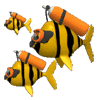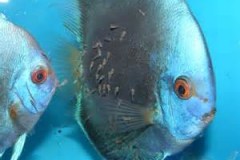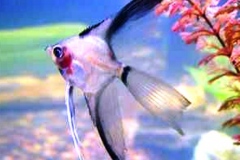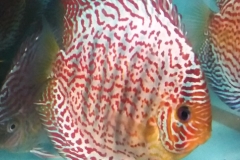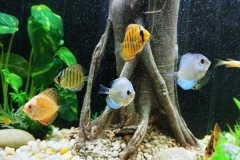Acclimation Instructions
Your new fish should be kept in a separate, bare, isolation tank for 2 weeks.
If you do not have a separate isolation tank, any other large container, such as a bucket or tub, that is free of chemicals may be used. Make sure that you put a heater and bubbler (a new sponge filter is best) in the temporary tank. Remember, this is only for two weeks. The temporary isolation tank should be a bare bottom tank with nothing in it other than the aeration and a heater (no plants, snails, fake plants, gravel, driftwood, decorations or other fish). Make sure everything in the isolation tank is completely sterile or new. After two weeks, When the fish are showing no signs of stress or disease, they can be moved to their permanent aquarium.
CHANGE 40 PERCENT OF THE WATER DAILY FOR THE FIRST WEEK AND THEN EVERY OTHER DAY FOR THE SECOND WEEK. MAKE SURE THAT YOU USE TREATED TAP WATER, DISTILLED WATER OR SPRING WATER. DO NOT USE CYCLED WATER OR WATER FROM OTHER TANKS.
It is urgent that you unpack your fish as soon as possible. Float the bag in the isolation aquarium where they are going to stay. DO NOT open the bag at this time! You may find that you need to remove some of the aquarium water to prevent it from overflowing when the bags are placed in the aquarium. If necessary, remove some aquarium water into a clean plastic bucket or other food safe receptacle. Be sure the container for excess water does not have any reside from household cleaners or other potentially toxic chemicals, as you will use this water to refill the aquarium later.
Allow the bags to float in the temporary tank for at least 45 minutes to allow temperatures to slowly equalize (longer if necessary). Open the fish bags only when you are ready to immediately put them into your aquarium and the temperature of the bag water and the tank water are the same. DO NOT put any water from your aquariums into the bags or vice-versa! Avoid netting as much as possible. Gently pour off most of the water from the bag thru a net. Then release the fish from the bag directly into the aquarium. Another good method uses a smooth plastic spaghetti strainer with small holes. Gently scoop or release the fish into the receptacle, drain the water and place the fish immediately into the aquarium. Large specimens can often be simply hand placed into the aquarium. If these methods are not applicable, place a large net over the top of a clean bucket with enough water to cover approximately a third of the bottom of the net. Open the bag and carefully pour some of the fish into the net and immediately place them directly into the aquarium. Try to avoid a net full of fish as they will ball up in the net, and the ones underneath can be damaged from compression and friction. Remember that water from the bag may react with the water from the aquarium, and could be very harmful. Never mix bag and aquarium water!
Sometimes during shipping, fish lie at the bottom of the bag and appear dead. “Playing opossum” is a common animal stress behavior. Carbon dioxide also acts to tranquilize the fish. Even if the fish look like they are mostly dead, put them into an aquarium as outlined above. Watch their mouths and gills for 5 minutes. If there is no movement of the mouth or gills for a full 5 minutes, it is dead. Leave the aquarium lights off to further reduce stress, and leave them alone. You will be amazed how clean water and stress reduction help!
Like other animals, fish produce carbon dioxide as they breathe. When carbon dioxide is dissolved in water, an acid is formed, lowering the pH of the water just like in a carbonated beverage. Fish also produce ammonia, which can be very damaging. Ammonia is present in water as NH3 or as NH4+, or as a combination of these forms. The toxic form of ammonia is NH3. The proportion of NH3 versus NH4+ is dependent on pH. The lower the pH, the lower the amount of NH3, and the greater the proportion of the less damaging NH4+. In the wild, freshwater fish naturally experience wide changes in pH.
One of the reasons fish can be shipped long distances in closed bags is because the pH in the shipping water drops, making the ammonia non-toxic. The carbon dioxide acts as a tranquilizer. When the bag is opened, and exposed to the outside air, carbon dioxide escapes, the pH of the water immediately begins to rise, and ammonia becomes deadly. Fish skin and gill damage will then occur very quickly. NEVER add water from a shipping bag into your aquarium, as you do not want all that harmful ammonia in your aquarium. NEVER add water from your aquarium into the shipping bag.
